Pre-modern Homo
Homo habilis fossils have been found in East and South Africa and dated to 2.4-1.4 Mya. His brain was slightly larger (550-680 cm3) than those of his predecessors. It has been claimed that the cranium shows evidence for a developed Broca’s area1, suggesting that he may have used spoken language to communicate, although Broca’s area is hardly a sufficient condition for speech. His face and teeth were smaller than those of australopiths, so maybe he was more carnivorous, but his body was more ape-like. He may have used stone tools, but it is difficult to know if these were made by him or by other species in the same region. Whatever the case, the supposition that he had done so resulted in his being considered the first homo. Nevertheless some researchers find little to distinguish between H. habilis and australopithecus. It also is not clear that H. habilis was an ancestor of H. erectus, as the time periods of the two overlapped by a half million years.
A recently found jawbone dating from 2.75-2.8 Mya, pushes back the date of the oldest fossil of genus Homo.1“Oldest human fossil found, redrawing family tree:, http://news.nationalgeographic.com/news/2015/03/150304-homo-habilis-evolution-fossil-jaw-ethiopia-olduvai-gorge/.
Homo rudolfensis lived in East Africa around 1.9-1.8 Mya. His brain was larger and his face longer than those of H. habilis, but his chewing teeth were larger, more like those of Paranthropus. Some paleontologists think he was an Australopithecus; some others, the same species as H. habilis. No good example of his skeletal structure has been discovered. A recent find of a cranium and jawbones.2New fossils confirm diverse species at the root of our lineage”. Smithsonian Human Origins Program,http://humanorigins.si.edu/research/whats-hot/australopithecus-sediba-%E2%80%93-new-analyses-and-surprises. http://humanorigins.si.edu/research/whats-hot/new-fossils-confirm-diverse-species-root-our-lineage supports the idea of H. rudolfensis as a Homo.
Homo ergaster (considered by many paleontologists to be early African H. erectus) lived 1.9-1.5 Mya in East Africa. He was the first hominin to have a body silhouette similar to that of modern humans and his proportions indicate that he lived on the ground. He was 1.7 m tall and capable of running and of walking long distances. His brain, at 850 cm3, was bigger than that of Paranthropus, but not yet that of a modern human, one more piece of evidence that larger brain size followed bipedalism on the evolutionary time scale, rather than preceding it. It is easy to imagine H. ergaster as the first “naked ape”. H. ergaster used primitive tools of the “Olduwan” culture.3Tools will be discussed in more detail in a later paragraph.
Homo erectus lived 1.9-0.14 Mya (or even later), making him the longest lived human species to date. Modern humans are far from having achieved such a long species lifetime. Like H. ergaster, H. erectus had a habitually upright posture and his or, in this case, her wide pelvis would have permitted birth of larger-brained babies.
H. ergaster/erectus (hereafter referred to simply as H. erectus) needed good nutrition in order to provide energy to that enlarging brain, so he may have mastered the use of fire and cooked his food, thus making food digestible even with his relatively smaller teeth. He was generally carnivorous, and the richer nutritive value of meat meant he could have a shorter digestive tract, which in turn made energy available faster. Hunting and butchering were enhanced by the use of double-sided stone cutting tools, which the archaeological record shows started around 1.76 Mya – the Acheulean technology. Note that 1.9 Mya, H. erectus coexisted with H. rudolfensis, H. habilis and P. boisei, and by .143 Mya, with H. sapiens.
H. erectus was the first species to expand beyond Africa, starting as early as 1.8 Mya. This was the first of many surges of expansion of hominins from Africa. Remains have been found in Asia (“Java man” in Indonesia, “Peking man” in China, Georgia), Africa and maybe Europe, although it is not impossible that some of these were different species. Migration will be discussed more later.
Several recent discoveries witness the work-in-progress character of paleoanthropology.
A skull discovered in 2001 from Dmanisi, Georgia, dated at 1.8-1.7 Mya possesses certain features of Homos habilis, erectus and rudolfensis, suggesting that they may not be distinct species.4“Complete skull from Dmanisi”. Smithsonian Human Origins Program, http://humanorigins.si.edu/research/whats-hot/complete-skull-dmanisi. This also is the oldest good fossil evidence for hominins outside Africa. Oldowan tools were found on the site.
Two more recent discoveries either clear up or confuse questions concerning H. erectus, depending on one’s point of view. One is the discovery in Buia (Eritrea) in 1998 of a nearly complete cranium, some pelvic bones and two incisors dated to 1.4-0.6 Mya. The long, ovoid brain case, wide cheekbones, massive brow ridges and medium-sized brain (~750-800 cm3, a preliminary result) make him look like H. erectus. However, the parietal bones of the cranium are claimed to represent a more modern trait. The discoverers see him as a link between H. erectus and H. sapiens and claim that the date of first H. sapiens morphology has been pushed back to around 1 Mya.
The second discovery comes from the Afar region of Ethiopia, where in 1997 a crushed skull was found in the Dakanihylo sedimentary layer, also dated to around 1 Mya. The reconstructed skull of this “Daka man” has a long, sloping forehead, massive brow ridges and brain case shaped rather like that of Buia man, giving him a resemblance to H. erectus specimens found at that time in far-away Asia. Since H. erectus first appeared around 1.8 Mya in Africa, the discoverers of Daka man claim this to be evidence that by 1 Mya, he had become one single world-wide species.
From 1.8 to 0.7 Mya, during the Pleistocene, glacial cycles increased in intensity. It was during this period that H. habilis and H. rudolfensis died out. The paranthropi soon followed suit, leaving only the genus Homo to spread to three continents.
Modern Homo
Homo heidelbergensis is considered by many paleontologists to be the first modern human. Fossils attributed to this species have been found in Germany, Greece, Ethiopia, Gambia, the U.K. and Spain, although he certainly originated in Africa. Some paleontologists think some specimens represent different species, such as H. antecessor (from Spain), H. cerpanensi (Italy) or H. rhodesiensis (Zambia). His large brain capacity of 1000-1300 cm3 confirms him as a Homo, although he had very large brow ridges and a flat face. He used fire and wooden spears, hunted large animals and built shelters of wood or rock. Some paleontologists think he was our ancestor, but wonder who was his. Many consider him to be a transition species between H. erectus and H. neanderthalensis. They lived between about 0.6 and 0.1 Mya.
Neanderthals
Homo neanderthalensis lived about 400-40 Mya over a large region extending from Western Europe into Asia, but concentrated mostly in Europe and the Near East. His body was shorter and more robust than that of modern humans, well adapted for cold, mountainous environments. His brain was even larger than ours, 1500-1750 cm3, but he weighed more, so his encephalization (ratio of brain mass to body mass) was similar. Neanderthals hunted large animals but also ate plants. They controlled fire, used sophisticated tools, lived in shelters and wore clothes they made themselves. Indeed, it is now thought that Neanderthals participated in about the same activities as H. sapiens. Discovery first of a Neanderthal hyoid bone (a throat bone necessary for enunciation) and then of his possessing the FOXP2 gene required for speech and language indicate that he may well have used language. Rock paintings found in Spain and dating from 43.5-52.5 Kya show that Neanderthals were artistic.
Much has been written about Homo neanderthalensis – entire books, including at least one novel sympathetic to him (William Golding, The Inheritors). Neanderthals are usually portrayed as ugly, ignorant, primitive and lacking in culture. They coexisted with H. sapiens for over 100,000 years and, in comparison with them, they were primitive and ignorant. But “ugly” is is in the eye of the beholder. And culture they had, though it is debated as to how much. There is evidence that they buried their dead and scratched designs into shells, an early example of art. It has recently been discovered that intercourse did take place between the species, as modern Europeans and their descendants have about 1-4% of their genes from Neanderthals. They therefore might be considered the same species as H. sapiens in spite of morphological differences. Which idea raises the question of what is a species.
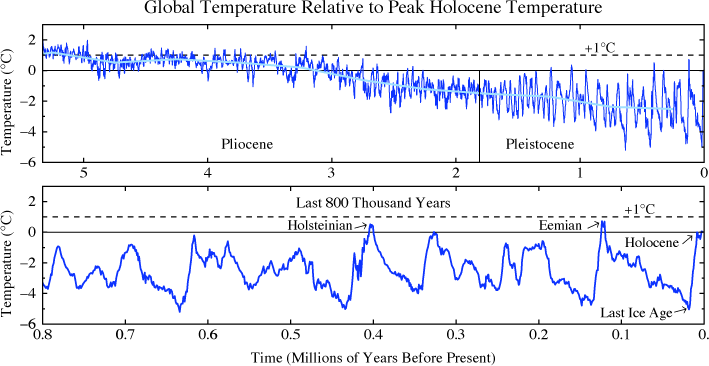
Global temperature over 6 My, from NASA Goddard Institute for Space Studies
The Earth was now subject to Milankovich-cycle glacial periods which came all the way down into northern continental Europe. During interglacial periods, such as those 500 and 400 Kya, Neanderthals penetrated northwards. During those of 320 and 220 Kya, they made it as far north as England and Wales. Between 120 and 70 Kya, they advanced as far as Siberia. But as the Earth became cooler after 100 Kya, they were forced to move south again. Their last holdouts were in Croatia, Russia and Gibraltar, not later than 28 Kya.
Neanderthals evolved during their long stay on Earth, as did their contemporary African Homos. Morphological traits distinguishing Neanderthals from modern man are more and more accented, the farther west they are found. Genetic studies of Neanderthals from across Eurasia suggest three different groups according to where they lived — western Europe, the Mediterranean and the East. So as modern man moved west from the Middle East, he met populations showing more distinct, because more developed, Neanderthal morphology. Neanderthal extinction followed the same East-West gradient, those in the east disappearing before those farther west.
Evolution and variation within a species complicates distinguishing the species from others. So stating that such a fossil is such a species is rather like taking a snapshot of a moving object.
Theories abound as to what brought about the demise of the H. neanderthalensis species. The principle accused are the rapidly fluctuating climate, competition for resources and physiological differences from their fellow man, H. sapiens. Opinions on this question are often influenced by species identification or political correctness. The jury is still out.
Denisovans
Less well known is the recently found Denisovan species, discovered only in 2008. First, a young girl’s finger bone was found in the Denisova cave in Southern Siberia. Since then, a toe and some teeth have also been found. While this may not sound like much, the important thing is that scientists have been able to make analyses of both nuclear and mitochondrial DNA of the species. Denisovans were found to be genetically closer to Neanderthals than to H. sapiens, but distinct enough to deserve being considered a separate species. More recent genetic studies suggest that Denisovans and Neanderthals had a common origin about 1 Mya which may have been H. heidelbergensis. Denisovans and Neanderthals then diverged around 640 Kya, after leaving Africa.
Denisovan genes have been found in the Melanesian people of Papua, New Guinea. Apparently, the people who migrated there first shared genes with the Denisovans before moving on to New Guinea 45 Kya. Denisovans may also have given present-day Tibetans a gene which facilitates living at high altitudes. And they make up around 1% of the genes of modern Europeans.
Homo sapiens
Bipedalism, temperature and a larger brain
To simplify only a little, all the characteristics of modern humans are due to two main traits: bipedalism and bigger brains. That is the correct chronological order, as small-brained Australopiths were already bipedal to some extent and evenly completely bipedal H. ergaster had a brain of only about 850 cm3. In some ways, bipedalism provided conditions necessary for an enlarged brain.
Bipedalism led to a non-grasping foot, simplified ankle and knee joints, a narrow, vertical and bowl-shaped pelvis (to support innards), related modifications to the hip joint and femur (the thing old folks break so easily), and a vertical, S-shaped spine (which pains many of us). It also freed up the hand, which could then develop other skills, such as making tools. Upright walking is thought to have brought modifications in the spatial relations of throat components (pharynx, larynx) necessary for speech, but keeping us from breathing and swallowing simultaneously, once we are past puberty.
Most important, bipedalism led to temperature regulation in the body and to improved brain nourishment. Under the hot African sun, being upright meant that less light hit the body during the hottest time of day. So fur could disappear (except on top of the head). Improved temperature control came from sweat glands in the skin coupled with blood circulation, together constituting a natural heat pump capable of cooling or warming the body depending on external conditions. This allowed the maintenance of the strict temperature range needed by enzymes responsible for metabolic processes. Since a significant part of this takes place in the brain, bipedalism indirectly allowed a bigger brain. Also, upright walking requires less energy than moving about on all fours, leaving more energy for the brain. And since the upright posture allowed faster movement, men became better hunters and were able to obtain more meat protein, which provided more energy, from which – again – the brain gained. All these features reinforced each other.
In addition to an improved nervous system and cognitive ability, a larger brain contributed to changes in the face and skull structure. Food not only nourished the larger brain, it also played a roll in the evolution of the jaw and teeth needed for mastication. The chin, unique to H. sapiens, attaches muscles used for fine lip movements necessary for speech. The brain developed a basic language function, at least for a default form of grammar found the world over.
Bipedalism also is important because before man could move “out of Africa”, he had first to move out of the trees! Otherwise, he could never have crossed the very different landscapes which he encountered – forests, grasslands and sometimes even seas.
So changes in posture, internal organs, brain size and interaction with the environment followed one upon another in a continual evolution towards our present (temporary) state.
Where, when and how?
To answer the first two questions, where and when, the oldest fossils of H. sapiens are from Ethiopia and date from 200 Kya. Fossils, archeology (tools and art), genetics and language studies confirm (with some reservations) the “Out of Africa” model, which holds that hominoids all developed in Africa, mainly East Africa, and then expanded to the west of the world. The alternative model, the “multiregional” hypothesis, which posits that hominoids migrated long before and then developed into local variants on site, is generally considered erroneous. Still, it is true that a number of migrations did take place, such as the one by H. erectus around 2 Mya and the more recent ones around 60-45 Kya by modern humans. It seems that when modern humans, or archaic H. sapiens, wandered out to the rest of the world, they met and to some extent mixed genes with locally variant species evolved from the earlier migrants. This would explain the small percentages of Neanderthal and Denisovan genes in those of modern humans.
As usual in paleontology, there is dispute about which was the first modern human fossil to be found. Deserving or not, Cro-magnon man generally wins the prize, having been found in a cro (shelter) on the farm of Mr Magnon in south-central France in 1868.5Modern Homo bones known as the “Red Lady”, because they were smeared with ochre, had been discovered in Wales in 1822-23. These early H. sapiens were more robust than modern humans, but otherwise resembled them closely. Actually, some of them had bigger brains than we do.
Fossil remains of H. sapiens have been found in Romania from 35 Kya; southeast Asia, maybe 40 Kya; and in the New World in Alaska, c. 12 Kya, and the Clovis Culture in North America, 11 Kya. Evidence for the existence of pre-Clovis cultures in Pennsylvania dating from 14 and possibly up to 20 Kya is controversial.
By 40 Kya, Homo’s skill at tool-making had increased to the point where he began to make works of art – cave paintings and engravings, and carved bones.

Painting in the Grotte de Lascaux, by Prof saxx via Wikimedia Commons
More about tools – the Paleolithic
Establishing a chronology for tool fabrication and use is difficult for at least two reasons. First, the only tools which have remained over time are the hard ones – made of stone or fossilized bone. Tools made of softer materials such as wood or bone have not survived. Second, finding tools near a fossilized hominin remain does not necessarily prove that the tools were made or used by that particular hominin. Still, we must do our best with the facts available.
The Paleolithic, or Old Stone Age, is taken as extending from the first known appearance of stone tools about 3.3 Mya in Kenya6Before 2014, the oldest was 2.6 Mya in Ethiopia. and extending to the end of the last Ice Age about 10 Kya. It is divided into three periods.
- The first is the Early Paleolithic (also called the Lower Paleolithic, because the corresponding geological layer is located below the others), which is divided into two overlapping periods according to prevalent technologies.
- The first period, the Oldowan (after Olduvai Gorge), extended from at least 2.6 Mya to about 1 Mya. During this time, hammerstones were used to knock sharp-edged chips off core rocks to make choppers. They were made and used by late australopithecines and maybe by paranthropus and H. ergaster/habilis. It was also during this time that the first expansions of Homo from Africa took place.
- The second period, from 1.7 Mya to about 250 Kya, was that of the Acheulean technology, which spread from Africa into the Middle East and on to India, south of the Movius Line. This technique made double-sided chips to use for such items as hand axes. Such technology required planning by the toolmaker and therefore augmented brain power. Hominins of the period were H. erectus and, later, H. heidelbergensis.
 Oldowan chopper from Ethiopia, by Didier Descouens via Wikimedia Commons |
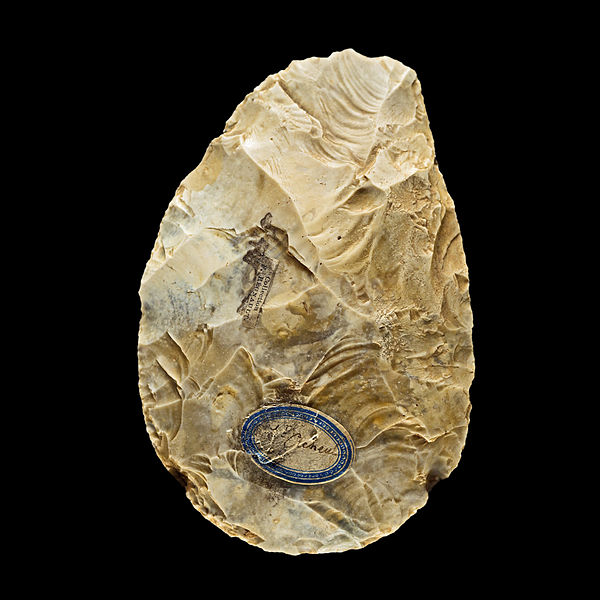 Biface from Saint Acheul, France, from Wikimedia Commons |
- The Middle Paleolithic, about 250-30 Kya, introduced the technique of making fine flakes of stone which could be attached to sticks to make spears. Fire came into general use. Principal hominins were Neanderthals and earliest modern humans.
- The Late Paleolithic, about 40-10 Kya, saw the use of bone, antlers and ivory to make still finer tools such as needles or harpoons. Hunting and fishing thus improved. Symbolic art, musical instruments and throwing devices dating from this period were made and used by anatomically modern humans. The oldest known musical instruments are bone flutes from 35 or more Mya, but most likely there had been previous instruments of less survivable material.

Paleolithic flute from about 43 Kya, by José-Manuel Benito Álvarez via WIkimedia Commons
As mentioned, examples of H. erectus have been dated in Asia up to around 2 Mya. The tools found with them were those of the Oldowan technique. Acheulean tools date back to to 1.76 Mya and have been found only south of a line running from present-day Denmark to the Gulf of Bengal, the so-called Movius Line, named after the paleontologist who first noted this distribution. The explanation for this geographical distribution is generally agreed to be that H. erectus first took his Oldowan tools with him when he migrated east before around 2 Mya. Later, the Acheulean developed in East Africa (even though it is named after a site in France where it was first discovered) and subsequent migrations carried it to most of the rest of Africa and the Near East (Georgia), from where it moved east into India and northwest into Europe around 600 Kya. Asiatic H. erectus eventually died off and were replaced by H. sapiens.
Similar considerations hold for the arrival of modern man in Europe. H. erectus seems to have arrived in southern Europe over 1 Mya; chipped stone tools have been found from 1.2 Mya. Although the Acheulean technology originated in Africa around 1.4 Mya, there are no examples of it in Europe from this time, This fact is explained if we accept that early hominins in Europe descended from those in Georgia 1.7 Mya, as this was a logical station between eastern Africa and Europe. Because of glacial periods which affected Europe over this period, there were most likely numerous attempts at settling during warm periods, many of which failed due to climate extremes: The settlement of Europe was not a one-time event. Only for the last 600 Kys has northern Europe (north of the Alps) been permanently settled and these settlers brought the Acheulean technology with them.
So for the cases of both Asia and Europe, absence of Acheulean tools for the earlier peoples leads to the recognition of different waves of migration across hundreds of thousands of years.
Summary of expansion of Homo sapiens
Evidence from paleontology, archeology and genetics all concur that modern man originated in Africa around 150 Kya. But even before that time, pre-modern Homo had begun what became the expansion of man from Africa to the rest of the world. The first step took place about 2 Mya when H. erectus, or whatever preceded him, spread out into Eurasia. His earliest known descendants lived in Georgia about 1.8 Mya. A second migration may have taken place about 200 Kya into China and India. Another around 130 Ky spread into the Middle East. Humans may have reached Australia 60 Kya.
But the big one, “ours”, so to speak, was the expansion around 60-50 Kya into the Middle East and thence into Europe and Asia. These Homo sapiens replaced the Neanderthals and H. erectus and, about 11 Kya, they made it to the Americas via Siberia. Man became the dominant species on Earth, for better and for worse.
Overall summary
After dinosaurs disappeared from the surface of the Earth about 65 Mya, the number and size of mammal species took off, eventually ranging in size from tiny mouse-like creatures up to elephants and whales. During a particularly warm period of the mid-Eocene, primates came into existence, at first small squirrel-like creatures. About 23 Mya, the primate line split into Old-World Monkeys (catarrhines) and hominoids and the latter split into hylobatids (gibbons and the like) and hominids. From hominids sprang pongines (orangutans) and hominines and the latter begat panins (chimps and bonobos) and hominins. The first hominins were the precursors of man, but not all of them were his ancestors. No direct line from the LCA7Last Common Ancestor of chimps and hominins can be distinguished; the tree of life is rather a bush, with the branches hidden and many twigs representing dead ends. However, there is clear evidence for over twenty species intermediate between the time of the LCA and modern Homo.
First, there were some fairly difficult-to-classify species found in East and Central Africa, dating from 7 to 4.5 Mya. Though the consensus seems to be that these represented steps in a generally man-like direction, they are all subject to controversy as to whether they are hominins or on another line. Some even may have lived before the LCA.
Then, from 4.5 to 2.5 Mya, there evolved a fairly heterogeneous group called australopithecines, one genus of which was australopithecus. Although they possessed varying degrees of bipedalism and stronger chewing teeth, their brains were still about the size of a chimp’s. Up to at least four of these species lived at the same time. A second group, which followed up to about 1 Mya was paranthropus, sometimes classed as a genus of australopithecines. These were more robust versions of australopithecus, with a chewing apparatus capable of masticating tough roots and nuts.
From around 2.5 Mya, true Homo, the same genus as modern humans, appeared on the scene. Members of these species tamed fire and invented cooking, made and used stone tools and hunted large animals. The first one to really look more or less like a modern human, Homo ergaster, had long legs, an upright body and could walk long distances and even run. Another (or maybe they were the same), Homo erectus, migrated out of East Africa as far as Asia around 2 Mya, taking along Oldowan tool technology. More migrational surges took place until finally, around 60,000 years ago, another, more modern species made their way into the Middle East and from there to Europe, Asia and, eventually, the Americas, this time with the Acheulean technology. Along the way, they mixed their genes with those of the local populations evolved from earlier H. erectus – Neanderthals and Denisovans and perhaps others. Nevertheless, most of our genes originated in Africa over ~60 Kya.
The best-known of the Homo which became extinct is Homo neanderthalensis. Neanderthals have been the victims of much bad press. Compared to the H. sapiens, with whom they shared the environment during their last 100,000 years or more, they were primitive. But they made and used tools and their own clothing, they probably buried their dead and they made decorations which may be considered an early form of art. And they left some of their genes in us.
The demise of the Neanderthals left, for the first time, only one species of hominin on Earth – H. sapiens sapiens. We are now up to the geological present.
Notes
| ↑1 | “Oldest human fossil found, redrawing family tree:, http://news.nationalgeographic.com/news/2015/03/150304-homo-habilis-evolution-fossil-jaw-ethiopia-olduvai-gorge/. |
|---|---|
| ↑2 | New fossils confirm diverse species at the root of our lineage”. Smithsonian Human Origins Program,http://humanorigins.si.edu/research/whats-hot/australopithecus-sediba-%E2%80%93-new-analyses-and-surprises. http://humanorigins.si.edu/research/whats-hot/new-fossils-confirm-diverse-species-root-our-lineage |
| ↑3 | Tools will be discussed in more detail in a later paragraph. |
| ↑4 | “Complete skull from Dmanisi”. Smithsonian Human Origins Program, http://humanorigins.si.edu/research/whats-hot/complete-skull-dmanisi. |
| ↑5 | Modern Homo bones known as the “Red Lady”, because they were smeared with ochre, had been discovered in Wales in 1822-23. |
| ↑6 | Before 2014, the oldest was 2.6 Mya in Ethiopia. |
| ↑7 | Last Common Ancestor |

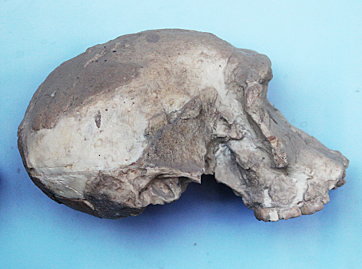

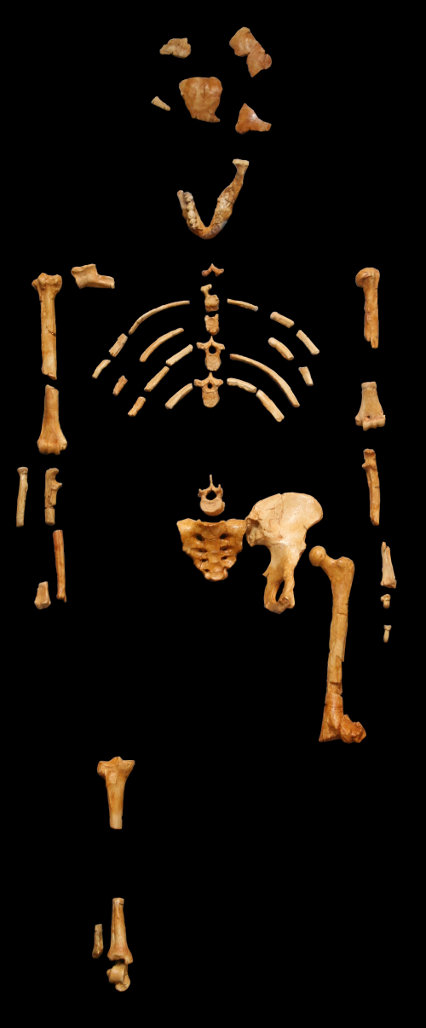
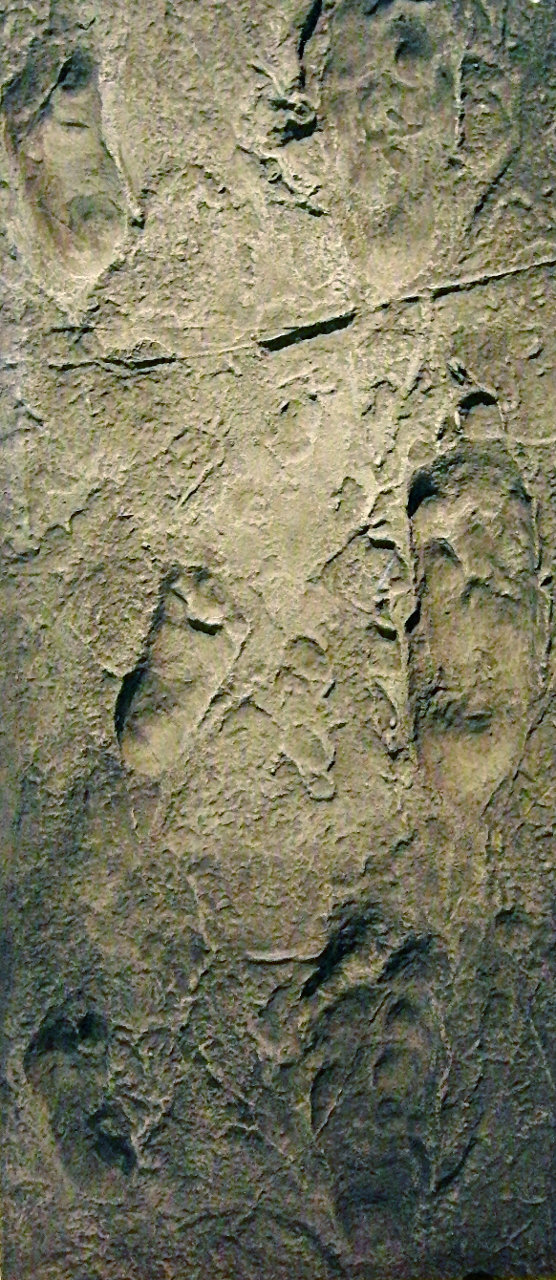
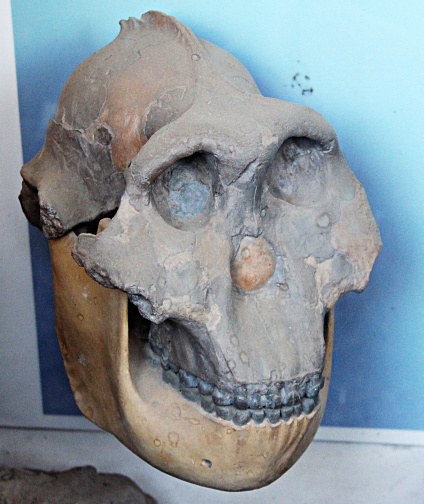
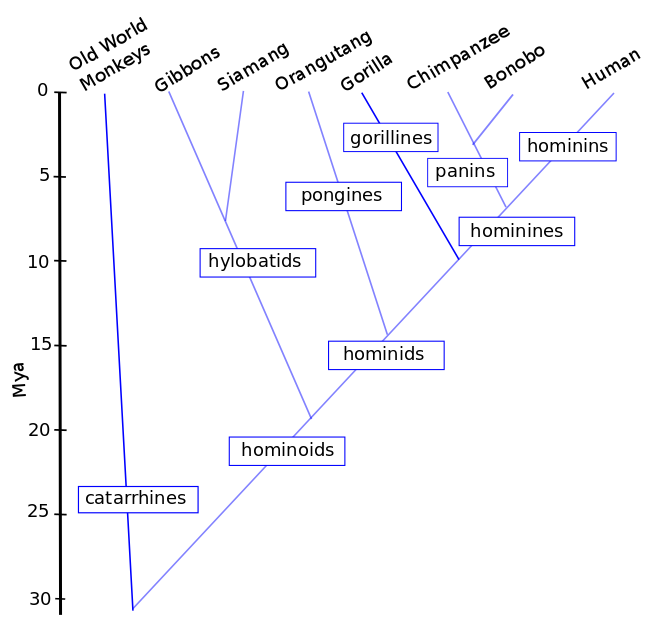
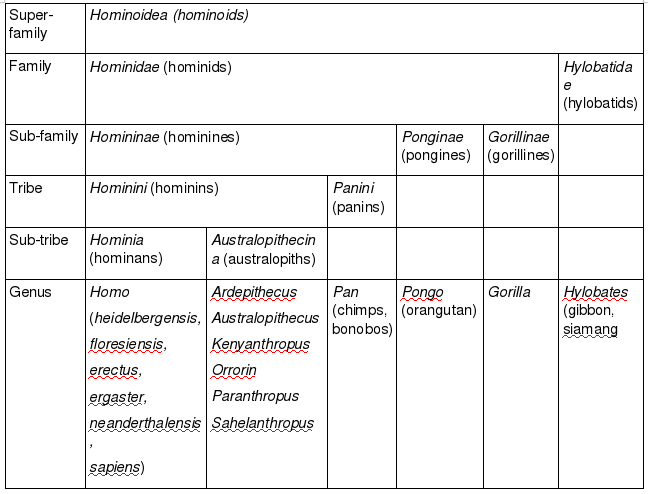
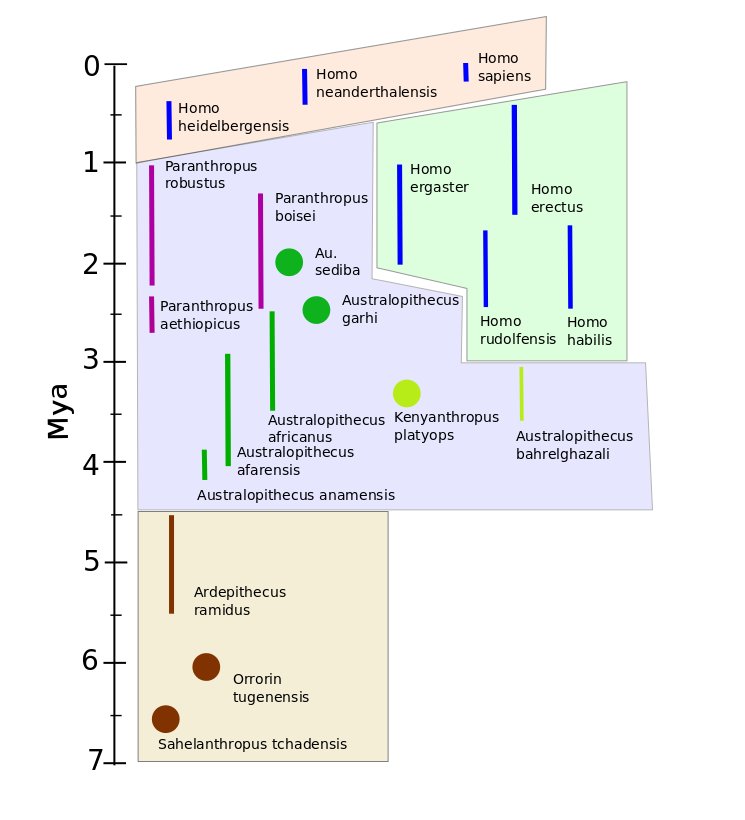
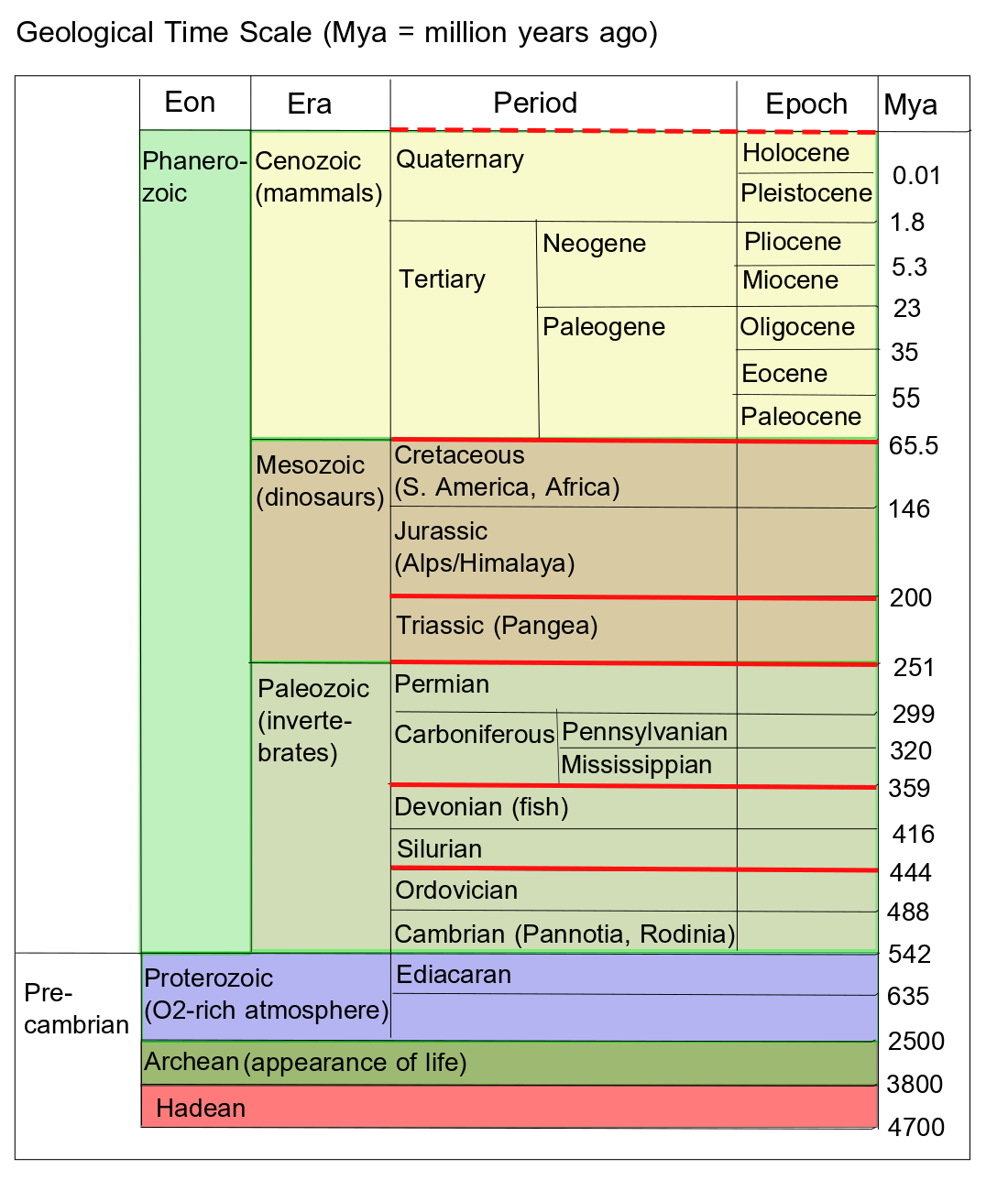

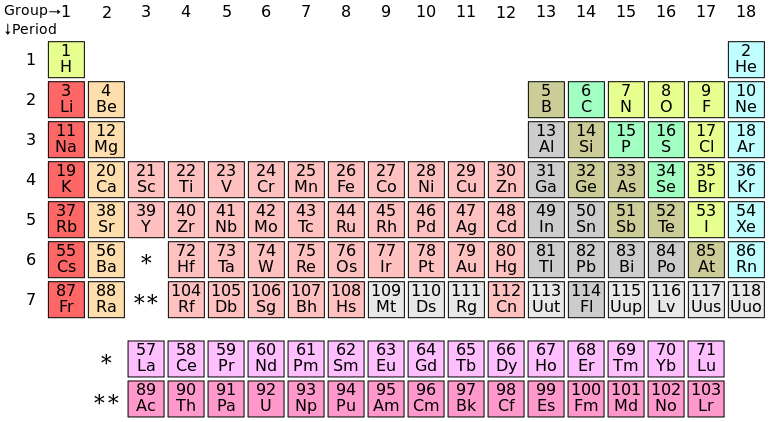
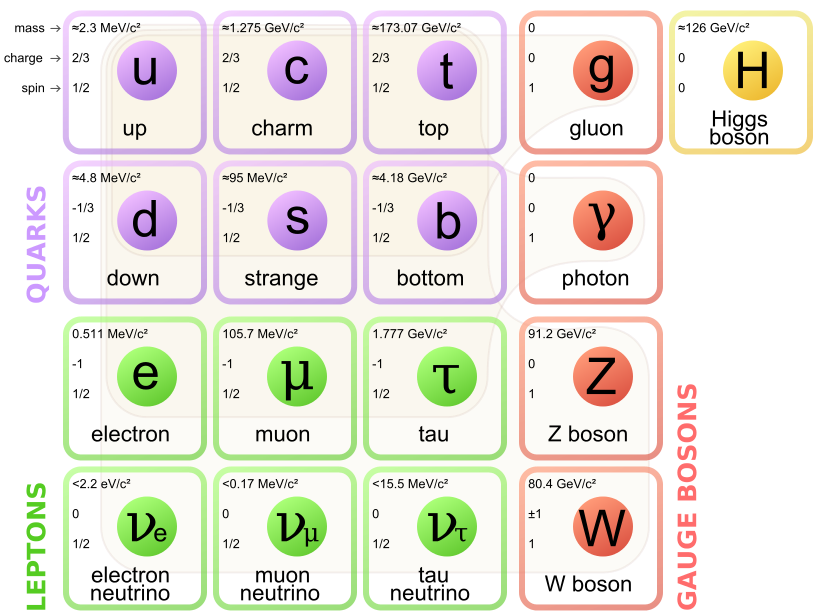
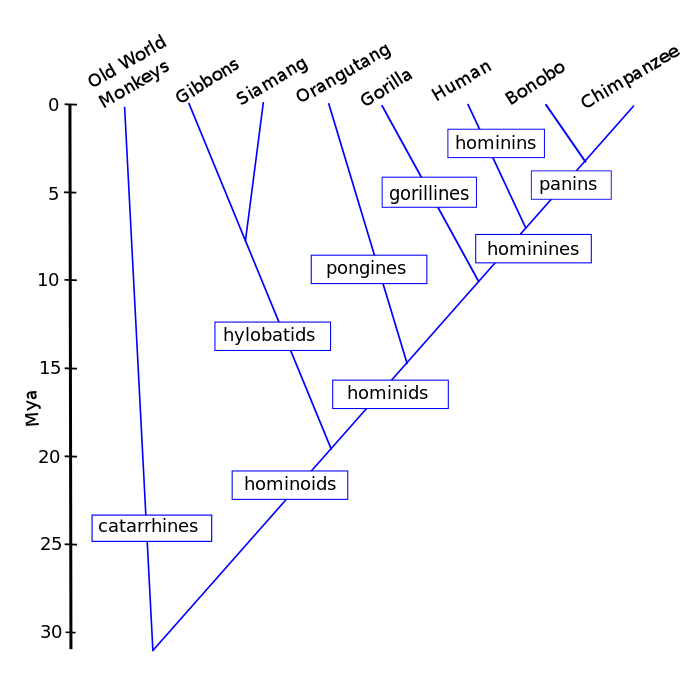
![Phylogenetic tree By MPF [Public domain], via Wikimedia Commons](http://natural-universe.net/wp-content/uploads/2015/07/800px-PhylogeneticTree.png)
